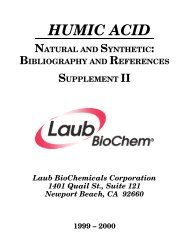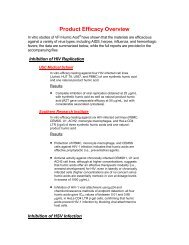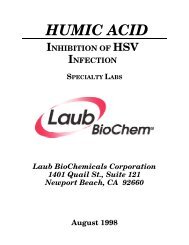HUMIC ACID - Laub BioChem
HUMIC ACID - Laub BioChem
HUMIC ACID - Laub BioChem
- No tags were found...
You also want an ePaper? Increase the reach of your titles
YUMPU automatically turns print PDFs into web optimized ePapers that Google loves.
EP 1 007 068 B1510152025303540455055113(6), 903-909; M. Jakubiec, E. Miszczak, and J. Szczerkowska, Acta Microbiol. Pol. [B] 1971,3(1), 63-66; R. Ansorgand W. Rochus, Arzneimittelforschung 1978, 28(12), 2195-2198; J. Pommery, M. Imbenotte, A. F. Urien, D. Marzin,and F. Erb, Mutat. Res. 1989, 223(2), 183-189; F. J. Lu and Y. S. Lee, Sci. Total Environ. 1992, 114, 135-139; K.Wiegleb, N. Lange, and M. Kuhnert, DTW Dtsch. Tierarztl. Wochenschr. 1993, 100(10), 412-416; H. L. Yang, F. J. Lu,S. L. Wung, and H. C. Chiu, Thromb. Haemost. 1994, 71(3), 325-330; W. Seffner, F. Schiller, R. Heinze, and R. Breng,Exp. Toxicol. Pathol. 1995, 47(1), 63-70; and J. Schneider, R. Weis, C. Manner, B. Kary, A. Werner, B. J. Seubert, andU. N. Riede, Virology 1996, 218(2), 389-395.[0040] The enzymatic catalytic synthesis of humic acids dates to about 1961 with the work by R. E. Hampton andR. W. Fulton, Virology 1961, 13, 44-52 (see also R. E. Hampton, Phytophathology 1970, 60, 1677-1681), who foundthat enzymatically oxidized phenols inactivate phytopathogenic (i.e., plant-related) viruses. Typically o-diphenol oxidasehas been employed for the enzymatic synthesis of humic-like materials: anon. Zentralbl. Bakteriol. [Orig. A] 1976,234(2), 159-169; R. Klocking, B. Helbig, and P. Drabke, Pharmazie 1977, 32(5), 297; K. D. Thiel, B. Helbig, R. Klocking,P. Wutzler, M. Sprossig, and H. Schweizer, Pharmazie 1981, 36(1), 50-53; K. D. Thiel, B. Helbig, M. Sprossig, R.Klocking, and P. Wutzler, Acta Virol. 1983, 27(3), 200-208; K. D. Thiel, P. Wutzler, B. Helbig, R. Klocking, M. Sprossig,and H. Schweizer, Pharmazie 1984, 39(11), 781-782; and G. Sydow, V. Wunderlich, R. Klocking, and B. Helbig, Pharmazie1986, 41(12), 865-868.[0041] A direct comparison of humic acids synthesized enzymatically and nonenzymatically from caffeic and hydrocaffeicacids has shown that the two synthetic routes produce materials that differ somewhat in their efficacy for thesuppression of herpes (hominis) types 1 and 2 viruses: K. D. Thiel, P. Wutzler, B. Helbig, R. Klocking, M. Sprossig,and H. Schweizer, Pharmazie 1984, 39(11), 781-782. D1,WO-A-8-403 299, relates to the immobilisation of enzymeson synthetic polymeric supports in order to provide stability compared to free enzymes succumbing to rapid degradation(cf. page 1, lines 1-2 and lines 24-29). In order to provide synthetic humic structures, phenolic compounds resemblinghumic polymeric structures are polymerised and from the basis for complexing the enzyme (cf. page 2, 2 nd para., page3, lines 17-29. D1 however, fails to disclose the particular process as established in claim 1 and further is silent on ananti-viral or anti-microbial use of compositions resulting from the manufacture process according to claim 1.D2, WO-A-9 106 589, discloses the synthetesis of polymers and analogues of aurintricarboxylic acid (ATA) and their use as antiretroviralagents against HIV (cf. abstract, page 3, lines 34-37, page 4, 1 st para.). As observed above, also D2 is silenton a process as defined in claim 1 and anti-viral/anti-microbial compositions resulting therefrom.D3, EP-A-544 321,discloses the use of substituted cinnamic acid polymers in the treatment of AIDS (cf. page 2), 1 st para. and lines50-54) but has no reference neither to the process nor to compositions comprising the products of said process.D4,Chem. and Pharm. Bull. 40 (8), 1992, pp. 2102-2105, H Nakashima et al., publishes the fact that a class of syntheticlignins (dehydrogenation polymers of p-coumaric acid, feluric acid, caffeic acid), in a similar way as natural lignin structures,inhibit HIV replication and may prove to be effective in the treatment of AIDS (cf. abstract). D5,Jour of Generaland Applied Microbiology, 38(4), 1992, pp 303-312, Patrick K. Lai et al., reports the inhibiting activity of polymericphenylpropenoids form pine cone extracts on the replication mechanism of type-1 human immunodeficiency virus (cf.abstract and discussion on page 311).D6, Pharmazie, 40(4), 198/5, p. 282, U. Eichhom, B. Helbig, R. Klöcking et al.,reports the antiviral effects of phenolic polymers (e.g., caffeic and hydrocaffeic acid) against Herpes virus and Coxsackievirus (cf.abstracts 2 and 3 on page 282). However, no reference is made to a composition resulting from the processdepicted in the present claim 1.D7, Chemical Abstracts 109/7) 15.8.1988, Abs no. 53911y, Soil Biol. Biochem, 198820(2), pp 227-231, cited in the International Search report, reports the use of huminates (phenolic polymers) in theinhibition of HIV-1 infection). D8EP-A-537 430, cited in the international Search Report, discloses the antiviral activityof ammonuim- and alkaline huminates against various viral infections (cf. abstract and page 2, lines 29-34).[0042] German patent DE 3830333 C1 (15 March 1990) issued to Wagner discloses a pharmaceutical compositioncomprised in part of humic acid for the topical treatment of herpes virus-induced vesicular rash. The method of preparationof the humic acid utilized is not disclosed.[0043] U.S. patent 4,999,202 (12 March 1991) issued to Cronje, et al disloses a composition that has bactericidalor bacteriostatic properties, and which comprises oxidized coal-derived humic acid or a salt or derivative thereof asthe active ingredient in a suitable carrier. The active ingredient is preferably an alkali metal salt of coal-derived humicacid and the carrier is preferably water. The method of preparation involves recovery of the humic acid by precipitation,after acidification with an acid such as hydrochloric acid to a pH value of 2.[0044] European patent application 0537430A1 (21 April 1993) from Riede, et al. discloses the use of natural orsynthetic, modified or unmodified ammonium or alkali metal humates against viruses, especially against retrovirusessuch as HIV. Riede et al. disclose humates that have insignificant toxicity and are neither mutagens nor teratogens.Riede, et al. also disclose a specific synthetic preparation of said humates that requires as long as 10-15 days tocomplete the oxidation of the starting material during which time the reaction temperature is maintained below 40°C.The solution is acidified to pH 4-5 following the synthesis, following which known methods of purification, such aspreparative chromatography, ultrafiltration, centrifugation, or electrodialysis, are employed. No inorganic salts otherthan the oxidant or the starting material are employed during or after the synthesis.8










